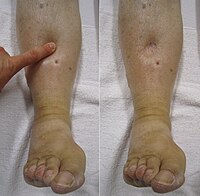
Magnetic resonance elastography‐derived stiffness of the kidneys and its correlation with water perfusion
Sign Up to like & getrecommendations! Published in 2019 at "NMR in Biomedicine"
DOI: 10.1002/nbm.4237
Abstract: Stiffness plays an important role in diagnosing renal fibrosis. However, kidney stiffness is altered by perfusion changes in many kidney diseases. Therefore, the aim of the current study is to determine the correlation of kidney… read more here.
Keywords: stiffness kidneys; water; water intake; bladder volume ... See more keywords

Describing water intake in six countries: results of Liq.In7 surveys, 2015–2018
Sign Up to like & getrecommendations! Published in 2018 at "European Journal of Nutrition"
DOI: 10.1007/s00394-018-1746-6
Abstract: In 2015, a collection of papers in this journal reported Liq. In7 survey findings, which suggested that, in many countries around the world, water intake may not meet adequate intake (AI) recommendations [1]. The papers… read more here.
Keywords: describing water; water intake; water; liq in7 ... See more keywords

Fluid and total water intake in a senior mediterranean population at high cardiovascular risk: demographic and lifestyle determinants in the PREDIMED-Plus study
Sign Up to like & getrecommendations! Published in 2019 at "European Journal of Nutrition"
DOI: 10.1007/s00394-019-02015-3
Abstract: Purpose We aimed to evaluate associations between compliance with recommendations for total water intake (TWI) and total water intake from fluids (TWIF), and some socio-demographic and lifestyle factors of a senior Mediterranean population at high… read more here.
Keywords: water; water intake; total water; demographic lifestyle ... See more keywords

Hydration for health hypothesis: a narrative review of supporting evidence
Sign Up to like & getrecommendations! Published in 2020 at "European Journal of Nutrition"
DOI: 10.1007/s00394-020-02296-z
Abstract: Purpose An increasing body of evidence suggests that excreting a generous volume of diluted urine is associated with short- and long-term beneficial health effects, especially for kidney and metabolic function. However, water intake and hydration… read more here.
Keywords: water intake; evidence; review; health ... See more keywords

A review on water intake in dairy cattle: associated factors, management practices, and corresponding effects.
Sign Up to like & getrecommendations! Published in 2022 at "Tropical animal health and production"
DOI: 10.1007/s11250-022-03154-2
Abstract: In this changing climate scenario, the availability of potable water has become scarce for both humans and animals in many parts of the world. Continuous supply of water is crucial for animals' life as well… read more here.
Keywords: availability; dairy; intake dairy; water intake ... See more keywords

The effects of feeding cut plantain and perennial ryegrass-white clover pasture on dairy heifer feed and water intake, apparent nutrient digestibility and nitrogen excretion in urine
Sign Up to like & getrecommendations! Published in 2017 at "Animal Feed Science and Technology"
DOI: 10.1016/j.anifeedsci.2017.04.023
Abstract: Abstract Urinary nitrogen concentration ( UN cc ) and urinary N excretion ( UN ) are directly associated with the nitrogen ( N ) leaching potential of soil and greenhouse gas emissions from grazing ruminants’… read more here.
Keywords: nitrogen; excretion; water intake; dairy ... See more keywords

Anorexigenic effects of mesotocin in chicks are genetic background-dependent and are associated with changes in the paraventricular nucleus and lateral hypothalamus.
Sign Up to like & getrecommendations! Published in 2019 at "Comparative biochemistry and physiology. Part A, Molecular & integrative physiology"
DOI: 10.1016/j.cbpa.2019.03.009
Abstract: Mesotocin (MT) decreases food intake and induces hyperthermia in chicks although hypothalamic mechanisms are unknown. The purpose of this study was thus to investigate effects of receptor antagonists and MT on feeding behavior and hypothalamic… read more here.
Keywords: water intake; food intake; physiology; receptor ... See more keywords

A Novel Cortical Mechanism for Top-Down Control of Water Intake
Sign Up to like & getrecommendations! Published in 2020 at "Current Biology"
DOI: 10.1016/j.cub.2020.09.011
Abstract: Water intake is crucial for maintaining body fluid homeostasis and animals' survival [1-4]. In the brain, complex processes trigger thirst and drinking behavior [1-5]. The anterior wall of the third ventricle formed by the subfornical… read more here.
Keywords: mechanism; water intake; water; drinking behavior ... See more keywords

The Effect of Water Flavor on Voluntary Water Intake in Hospitalized Horses.
Sign Up to like & getrecommendations! Published in 2021 at "Journal of equine veterinary science"
DOI: 10.1016/j.jevs.2020.103361
Abstract: Hospitalized horses are at risk for colic due to several factors, all of which may reduce voluntary water intake (VWI) further contributing to the development of colic during hospitalization. Our objectives were to determine if… read more here.
Keywords: voluntary water; water; water intake; flavored water ... See more keywords

Fibroblast growth factor 19 stimulates water intake
Sign Up to like & getrecommendations! Published in 2022 at "Molecular Metabolism"
DOI: 10.1016/j.molmet.2022.101483
Abstract: Fibroblast growth factor 19 (FGF19) is a hormone with pleiotropic metabolic functions, leading to ongoing development of analogues for treatment of metabolic disorders. On the other hand, FGF19 is overexpressed in a sub-group of hepatocellular… read more here.
Keywords: growth factor; fibroblast growth; fgf19; water intake ... See more keywords

Nax-positive glial cells in the organum vasculosum laminae terminalis produce epoxyeicosatrienoic acids to induce water intake in response to increases in [Na+] in body fluids
Sign Up to like & getrecommendations! Published in 2020 at "Neuroscience Research"
DOI: 10.1016/j.neures.2019.05.006
Abstract: Nax is a [Na+] sensor expressed in specific glial cells in the sensory circumventricular organs (sCVOs) in the brain. We recently demonstrated that Nax signals are involved in the control of not only salt intake… read more here.
Keywords: increases body; glial cells; body fluids; water ... See more keywords